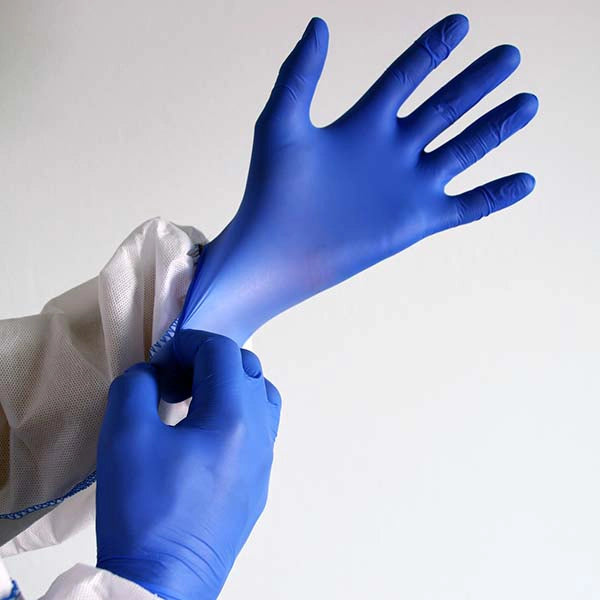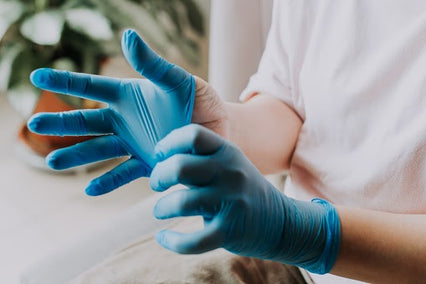When you buy gloves, you tend to focus on the job. But what about what happens to your gloves after they leave the box and complete their use?
The truth is, how your gloves are disposed makes a huge difference in the sustainability of your purchased supplies, materials, and your overall facility.
Whether you’re a lab, a health care organization, a major company, an industrial plant, or anything in between, here’s a look at how to properly dispose of nitrile gloves to take care of the environment.
How to Recycle Nitrile Gloves in 3 Easy Steps
In order to understand the recycling process for nitrile gloves, it helps to understand the recycling process overall. It consists of a few basic steps.
The first step is collecting recyclable material and putting it in the right place for a recycling program to pick it up. After collecting materials, a recycling facility sorts, cleans, and processes recycled products into materials that can be bought and sold for consumer products just like other materials.
The next step is using those recycled materials for manufacturing. Several common household products are now made using recycled materials, such as drink containers, laundry detergent bottles, and steel cans. Recycling may also generate materials for use paving roads.
The last step of the loop is purchasing products made by recycling disposed products. These fall into three categories:
- Recycled content product
- Post-consumer content
- Recyclable product
Anything from paper towels to cereal boxes to carpeting can now be made using items sent to a recycling program instead of the trash.
Are Nitrile Gloves Recyclable?
You know your company needs to live up to your sustainability promises. But first, you have to know what you can recycle.
The good news is nitrile gloves are recyclable materials--and you should always recycle them if you can, since nitrile is less biodegradable than latex.
Are Latex Gloves Recyclable?
Latex gloves, commonly used in medical and industrial settings, are not as easily recyclable as nitrile gloves. While latex is a natural material, the gloves often contain additives and are contaminated after use, making the recycling process more complex. Specialized recycling programs can handle latex gloves, but they are less widespread. Therefore, it’s crucial to research and locate facilities that accept latex gloves for recycling to minimize environmental impact.
Are Vinyl Gloves Recyclable?
Vinyl gloves, made from polyvinyl chloride (PVC), present a significant challenge for recycling. The material itself is not biodegradable and contains plasticizers that can be harmful to the environment. Currently, there are very limited recycling options for vinyl gloves, and they often end up in landfills. To reduce environmental harm, consider alternatives to vinyl gloves where possible and stay informed about any emerging recycling programs that may accept them.
Are Hybrid Gloves Recyclable?
Hybrid gloves, which combine materials like nitrile, latex, and vinyl, offer versatility but complicate recycling efforts. Due to the mixed materials, these gloves are difficult to process in standard recycling facilities. The best practice for hybrid gloves is to seek out specialized recycling programs designed to handle multi-material products. As with other gloves, reducing use and switching to more recyclable options when possible can help lessen environmental impact.
Why You Need to Recycle Used Gloves
Unfortunately, the way we now live generates a great deal of waste--especially in labs, the medical field, and sanitation work, where disposable PPE is the norm and a necessary safety standard.
On average, high-income countries generate 0.5 kg of medical waste per hospital bed per day, while low-income countries generate 0.2 kg of waste per bed per day. 85% of this waste is general non-hazardous waste, while the remaining 15% is considered hazardous, toxic, or radioactive. However, in low-income countries, medical waste often isn’t separated into hazardous and non-hazardous, greatly increasing the amount of hazardous waste and unnecessary trash piling up in landfills.
Thanks to the COVID-19 pandemic, there’s been a sharp uptick in medical waste across the world. In Wuhan, where the pandemic first began, the daily output of medical waste reached 240 metric tons, the size of an adult blue whale. In the U.S., the environment is changing rapidly--including a rapid uptick in medical waste.
And with increasing attention on business sustainability and pressure to do your part to fight the climate crisis, plus the costs those wastes represent, it makes sense to recycle.
When Nitrile Should Go to Landfills
That said, while nitrile itself is a recyclable material, there is one specific case when nitrile should go to landfills instead of a recycling facility: when it’s hazardous waste.
Hazardous waste is a waste subset with certain properties that make it dangerous or capable of having a harmful effect on human health or the environment. In the case of a nitrile glove, for example, we’re often talking about biohazards or chemicals.
Basically, if the glove has been contaminated and is no longer safe to mix with other waste, it should be properly disposed of and not mixed with non-hazardous recyclables. Otherwise, the entire batch of recyclables is considered contaminated and must be thrown away.
Best Practices for Recycling Disposable Gloves
Not sure how to get your company on track with sustainability? The good news is that you have several options and resources for recycling nitrile gloves. It can be as involved or as basic as you like.
Basic Recycling
The easiest approach is a basic recycling program--which is likely something you already have.
To do this, all you have to do is start incorporating nitrile gloves into your general recycling bins. Every uncontaminated single-use nitrile glove should be placed with undifferentiated dry products.
However, if a nitrile glove qualifies as hazardous waste, it should be disposed of using the proper hazard disposal procedures. It should not be mixed with your recycling. Anything from a lab glove contaminated with chemicals to an examination glove that qualifies as a biohazard should go in the trash. Otherwise, the whole recycling batch is contaminated.
Set Up a Recycling Program Partnership
If you want a more in-depth approach (and a specialist guarantee that you’ll get all your materials properly recycled) it pays to set up a partnership.
For gloves not considered hazardous waste, there are three green disposal options that your company can work with:
Each one offers slightly different glove recycling options, though they all follow the same basic premise: you purchase a box or bundle of boxes, and once the box fills with gloves, you ship it to the company, which then handles processing it at waste-to-energy facilities.
Don’t Forget to Educate Your Team
Of course, one of the most essential components of your recycling program has nothing to do with a glove box or waste facility. In order for your program to work, you have to educate your staff.
Remember, even a basic recycling program may be able to handle nitrile gloves. But if your team doesn’t know how to recycle gloves correctly or what gloves should be put in the trash, recycling won’t do any good. Always take your time to teach the rules of successful recycling.
Conclusion
When purchasing gloves, the focus often remains on their immediate utility. However, the disposal process significantly impacts the sustainability of your materials and overall facility operations. Properly disposing of nitrile gloves is essential for environmental care, whether you operate a lab, healthcare organization, industrial plant, or any other entity.
To ensure you meet your sustainability goals, it’s crucial to understand the recycling process for nitrile gloves and participate in specialized recycling programs. This helps reduce environmental impact and promotes responsible waste management. At gloves.com, we are committed to providing high-quality, sustainable glove solutions and supporting your efforts to create a more environmentally friendly workplace.
Visit gloves.com to explore our range of recyclable gloves and learn more about our recycling programs.
How To Recycle Nitrile Gloves: Frequently Asked Questions
Can you recycle nitrile rubber?
Yes, nitrile rubber can be recycled. Specialized recycling programs and facilities can process nitrile gloves and other nitrile rubber products. These programs break down the nitrile material and repurpose it into new products, helping to reduce waste and environmental impact.
How do you reuse nitrile gloves?
Reusing nitrile gloves is generally not recommended, especially in medical or laboratory settings, due to the risk of contamination and loss of integrity. However, for non-hazardous tasks, you can clean the gloves with soap and water, let them dry thoroughly, and inspect them for any damage before reuse. Always ensure that the gloves are not compromised and are suitable for the intended use.
Are nitrile gloves bad for the environment?
Nitrile gloves are less biodegradable than latex gloves, making them more challenging for the environment. However, they can be recycled through specialized programs, which helps mitigate their environmental impact. Proper disposal and participation in recycling programs are essential to reduce the environmental footprint of nitrile gloves.
What will degrade nitrile gloves?
Nitrile gloves can degrade when exposed to certain chemicals, extreme temperatures, and prolonged exposure to sunlight or UV light. Oils, solvents, and certain acidic or alkaline substances can also cause nitrile gloves to break down. It is essential to store nitrile gloves in a cool, dry place away from direct sunlight and to avoid contact with harsh chemicals to prolong their usability.





